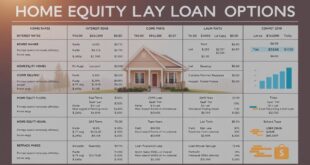If you own property, now might be the perfect time to leverage its value for your financial needs. With competitive options available, accessing funds through equity-based financing can help you tackle large projects or unexpected costs more affordably. Let’s explore how today’s market conditions could work in your favor.
Current offerings often include variable-rate plans tied to the Wall Street Journal Prime Rate, which may adjust over time. These terms are ideal for borrowers with strong credit profiles, offering initial discounts that lower upfront costs. However, it’s crucial to understand how lenders evaluate applications—factors like your credit history and property’s value ratio play significant roles.
Not all promotions are created equal. Some lenders advertise attractive short-term discounts that later shift to higher standard rates. By comparing options and improving your financial standing, you position yourself to secure the most favorable terms possible. Ready to take the next step?
Key Takeaways
- Variable rates often follow the WSJ Prime Rate, which changes periodically.
- Excellent credit scores increase eligibility for discounted introductory offers.
- Lenders assess loan-to-value ratios and credit history during approval.
- Promotional rates may differ from long-term financing terms.
- Strategic financial planning improves access to competitive deals.
Overview of Home Equity Loans and HELOC
Your property holds more value than just a place to live. Built-up ownership stake can become a financial resource through two popular solutions: traditional lump-sum agreements and flexible borrowing lines.
How Ownership Stake Works
Your available funds depend on your property’s market value minus what you owe lenders. For instance, a $200,000 house with $120,000 remaining on the mortgage leaves $80,000 in potential ownership value. Most institutions let you access up to 85% of this amount – $50,000 in this case.
Flexible Credit vs Fixed Agreements
A HELOC operates like a reusable credit card tied to your property’s worth. You draw funds as needed, paying interest only on used amounts. Traditional arrangements provide one-time cash injections with fixed repayment schedules.
Which option fits better? Flexible credit lines suit ongoing projects with unpredictable costs. Fixed-sum solutions work best for single large expenses like roof replacements. Both use your property as collateral but serve different financial strategies.
Understanding home equity loan rates
Your choice between fixed and adjustable terms could save thousands over time. Let’s break down how these options work in real-world scenarios.
Stability Versus Flexibility
Adjustable-rate plans often start lower but follow market trends. These terms connect to the WSJ Prime Rate, which lenders update periodically. For example, a current offer might show “Prime minus 0.5%” – a deal that shifts if economic conditions change.
Fixed agreements lock in one percentage for the entire term. Recent offers start around 7.34% APR for qualified borrowers. This predictability helps budget-conscious owners avoid payment surprises.
Lenders determine your exact terms using four factors:
- Credit score history
- Property value compared to existing debts
- Total financing amount
- Occupancy status (primary residence vs investment)
While adjustable options might seem cheaper initially, consider how rate hikes could affect payments. A 2% increase on a $50,000 balance adds $83 monthly. Fixed plans eliminate this risk but may cost more upfront.
Features and Benefits of a Home Equity Line of Credit
Need flexible financing without upfront expenses? Many lenders now offer attractive terms that make accessing your property’s value simpler than ever. These programs combine cost efficiency with user-friendly features designed for modern financial needs.
No Application Fees and Closing Costs
Save money from day one with programs that eliminate common expenses. Qualified applicants pay nothing to apply or close agreements under $1 million. Annual maintenance charges also stay at $0, keeping long-term costs predictable.
Want to lock in stable payments later? Convert variable balances to fixed terms without extra charges. This flexibility helps you adapt to changing financial goals effortlessly.
Flexible Access to Funds and Automatic Payment Discounts
Manage your credit line through online portals, mobile apps, or local branches. Request funds via secure transfers or specialty checks—all without access fees. Need a large initial withdrawal? Earn 0.10% off your rate for every $10,000 borrowed during setup, up to 1.50% total savings.
Set up automatic payments and enjoy an extra 0.25% discount. Preferred banking clients receive additional reductions from 0.125% to 0.625% based on account relationships. These layered savings add up quickly, making your financing work harder for you.
Comparing Home Equity Loan Types and Options
Smart financial decisions start with understanding how different borrowing tools work. Whether you prefer stability or flexibility, each option serves specific needs. Let’s break down two popular ways to access your property’s value.
Fixed-Rate Equity Loans Explained
Fixed agreements lock your percentage for the entire repayment period. This shields you from market changes, keeping monthly payments predictable. Recent offers start around 7.34% APR for qualified applicants.
These plans work best for one-time expenses like kitchen remodels. You’ll know exactly what to budget each month. However, they’re less ideal if you need ongoing access to funds.
Variable Rate HELOC Characteristics
Flexible credit lines let you borrow repeatedly up to your limit. Current variable rates begin at 7.75% APR for those with 750+ credit scores. The percentage adjusts based on market indexes like the WSJ Prime Rate.
Some lenders offer hybrid solutions. For example, you can convert $5,000+ of your balance to fixed terms later. This blends adaptability with stability as your needs evolve.
| Feature | Fixed-Rate Loan | HELOC |
|---|---|---|
| Rate Type | Unchanging | Adjustable |
| APR Range | 7.34%+ | 3.99% – 18% |
| Best For | Single expenses | Ongoing needs |
| Key Benefit | Payment consistency | Reusable funds |
Consider your timeline and risk tolerance. Fixed plans suit those prioritizing certainty, while credit lines benefit projects with shifting costs. Always review rate caps and conversion fees before deciding.
The Application Process for a Home Equity Loan
Digital advancements have transformed how borrowers secure funds against their assets. Modern lenders prioritize convenience, offering tools that simplify every step while protecting sensitive data.
Streamlined Digital Experience
Complete your request in about 15 minutes using any internet-connected device. The system guides you through each phase, automatically saving progress if interrupted. Required fields highlight essential details, reducing errors before submission.
After applying, access real-time updates through your secure portal. Most institutions provide:
- Instant confirmation of received materials
- Custom checklists for missing documents
- Appointment scheduling for property assessments
Processing typically takes 30-40 days from start to finish. Delays usually occur when verifying employment history or resolving title issues. Proactive document uploads can accelerate approvals by up to 10 days.
| Feature | Benefit | Time Impact |
|---|---|---|
| Digital Submission | 24/7 access | -2 days vs mail |
| Auto-Save Function | Resume applications | Saves 15 minutes |
| Document Scanner | Phone uploads | Instant verification |
| E-Sign Capability | Remote approvals | -3 business days |
Finalize agreements at any participating branch nationwide. Some providers offer mobile notary services for $50-$150 if visiting isn’t practical. Always review closing disclosures 72 hours before signing to confirm terms.
Managing Interest and Monthly Payments
Smart payment strategies can make your financing work better for you. Whether you’re budgeting for regular costs or preparing for rate changes, understanding these tools helps maintain financial stability.

Automatic Payment Options and Discounts
Enroll in automatic transfers from your bank account to simplify budgeting. Many lenders reward this convenience with a 0.25% rate reduction. This discount applies throughout your borrowing period, saving hundreds over time.
You’ll only pay interest on the amount you’ve actually used. If your credit line is $50,000 but you’ve borrowed $10,000, charges apply only to the smaller figure. This approach keeps costs proportional to your needs.
Handling Variable Interest Adjustments
Variable percentages change with market conditions, usually every 30-90 days. Track these shifts through your lender’s online portal or monthly statements. A 1% increase on a $20,000 balance adds about $16 to your monthly payment.
During the initial 10-year period, focus on interest charges while accessing funds freely. When repayment begins, budgets adjust to cover both principal and interest over 20 years. Planning for this transition prevents payment surprises.
| Phase | Duration | Payments Cover | Flexibility |
|---|---|---|---|
| Draw Period | 10 years | Interest only | Access funds anytime |
| Repayment | 20 years | Principal + Interest | Fixed schedule |
Home Equity Use Cases for Home Improvement and Debt Consolidation
Your property’s accumulated value can be a financial springboard for life’s big moments. Whether upgrading your living space or simplifying debt management, strategic planning helps maximize benefits while maintaining stability.
Enhancing Your Living Space
Transform your environment with upgrades that serve both comfort and value. Kitchen remodels typically recover 60-80% of costs during resale, while energy-efficient windows cut utility bills by 15% annually. Focus on projects offering dual benefits:
- Bathroom renovations with water-saving fixtures
- Landscaping that improves curb appeal
- Roof replacements using durable materials
Simplifying Multiple Debts
Combine high-interest obligations into one manageable payment. Credit card balances averaging 21% APR could drop to single-digit percentages through consolidation. This strategy works best when:
- You have $15,000+ in unsecured debt
- Your credit score exceeds 680
- Property value supports needed financing
| Debt Type | Average Rate | Potential Savings |
|---|---|---|
| Credit Cards | 20.75% | $4,200/year |
| Personal Loans | 11.50% | $1,800/year |
| Medical Bills | 18.00% | $3,000/year |
Unexpected costs like emergency repairs or educational fees become manageable with flexible access to funds. Always consult a financial advisor to align borrowing with long-term goals.
Cost Considerations and Closing Costs Advantages
Understanding the full picture of borrowing expenses helps you keep more money in your pocket. Many institutions now offer arrangements where they cover third-party charges, making financing more accessible.
Breaking Down Fee Structures
Typical agreements involve multiple charges. These might include property appraisals, title searches, and government recording fees. Some lenders absorb these expenses completely for qualified applicants.
Navy Federal, for example, eliminates origination fees and application charges. They also handle settlement costs and flood determinations. This approach saves borrowers $300-$2,000 on average for amounts under $250,000.
| Fee Type | Covered by Some Lenders? | Typical Cost |
|---|---|---|
| Appraisal | Yes | $300-$600 |
| Title Search | Yes | $200-$400 |
| Credit Report | Sometimes | $15-$40 |
| Recording | Varies | $25-$250 |
Follow these tips to maximize savings:
- Compare institutions offering zero application fees
- Ask about annual maintenance charges upfront
- Calculate total costs over 5+ years
Smart shoppers review both percentages and hidden charges. This dual focus ensures you get true value from your financial strategy.
Conclusion
Making informed decisions about your property’s financial potential can shape your future stability. Whether opting for a HELOC or fixed equity line, prioritize solutions aligning with your budget and goals. Flexibility matters—reusable credit options adapt to evolving needs, while structured repayment plans offer predictability.
Review all terms carefully, focusing on rate adjustment details and long-term costs. Many find combining high-interest balances like credit card debt into lower-rate agreements creates breathing room. Remember, your property’s value isn’t just about today—it’s a tool for building tomorrow.
Ready to explore possibilities? Compare offers, ask questions, and consult trusted advisors. With the right strategy, you’ll unlock opportunities that enhance both your finances and daily life.
FAQ
What’s the difference between a HELOC and a traditional loan?
How do variable rates affect monthly payments?
Are there fees to apply for a line of credit?
FAQ
What’s the difference between a HELOC and a traditional loan?
A HELOC works like a credit card, letting you borrow as needed during a draw period. Traditional loans provide a lump sum upfront with fixed monthly payments. Both use your property’s value but offer different flexibility.
How do variable rates affect monthly payments?
Variable rates can change with market conditions, which may increase or decrease your payment over time. Fixed rates stay the same, offering predictable costs for budgeting.
Are there fees to apply for a line of credit?
Many lenders offer
FAQ
What’s the difference between a HELOC and a traditional loan?
A HELOC works like a credit card, letting you borrow as needed during a draw period. Traditional loans provide a lump sum upfront with fixed monthly payments. Both use your property’s value but offer different flexibility.
How do variable rates affect monthly payments?
Variable rates can change with market conditions, which may increase or decrease your payment over time. Fixed rates stay the same, offering predictable costs for budgeting.
Are there fees to apply for a line of credit?
Many lenders offer $0 application fees and low closing costs. Always review terms to avoid surprises, like annual charges or early closure penalties.
Can I use funds for debt consolidation?
Yes! Borrowers often consolidate high-interest credit card balances into one lower-rate payment. This simplifies finances and may reduce interest expenses.
How quickly can I access funds after applying?
Online applications with document uploads speed up approval. Some lenders provide access in days, depending on verification and property appraisal timelines.
What discounts are available for automatic payments?
Enrolling in autopay might qualify you for a rate reduction (e.g., 0.25% off). Check with providers like Bank of America or Chase for specific offers.
Do renovation projects increase my property’s value?
Strategic upgrades—like kitchen remodels—can boost equity. Discuss plans with a financial advisor to align spending with long-term goals.
How do lenders determine my borrowing limit?
They’ll assess your loan-to-value ratio, credit score, and income. Most allow borrowing up to 85% of your home’s appraised value minus existing mortgage debt.
application fees and low closing costs. Always review terms to avoid surprises, like annual charges or early closure penalties.
Can I use funds for debt consolidation?
Yes! Borrowers often consolidate high-interest credit card balances into one lower-rate payment. This simplifies finances and may reduce interest expenses.
How quickly can I access funds after applying?
Online applications with document uploads speed up approval. Some lenders provide access in days, depending on verification and property appraisal timelines.
What discounts are available for automatic payments?
Enrolling in autopay might qualify you for a rate reduction (e.g., 0.25% off). Check with providers like Bank of America or Chase for specific offers.
Do renovation projects increase my property’s value?
Strategic upgrades—like kitchen remodels—can boost equity. Discuss plans with a financial advisor to align spending with long-term goals.
How do lenders determine my borrowing limit?
They’ll assess your loan-to-value ratio, credit score, and income. Most allow borrowing up to 85% of your home’s appraised value minus existing mortgage debt.
 Website Teknologi Terupdate
Website Teknologi Terupdate







